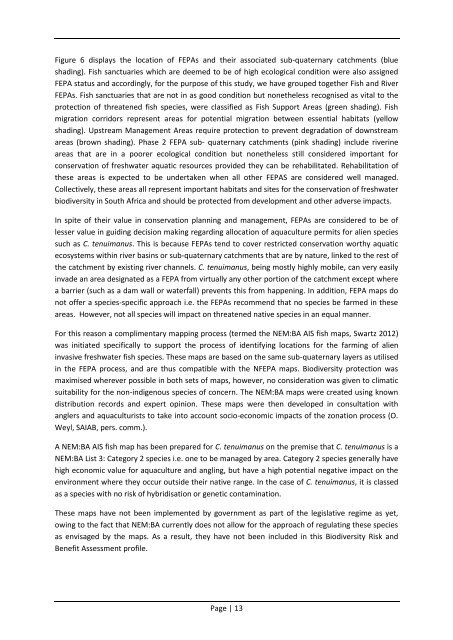Marron, freshwater crayfish Cherax tenuimanus - Department of ...
Marron, freshwater crayfish Cherax tenuimanus - Department of ...
Marron, freshwater crayfish Cherax tenuimanus - Department of ...
You also want an ePaper? Increase the reach of your titles
YUMPU automatically turns print PDFs into web optimized ePapers that Google loves.
Figure 6 displays the location <strong>of</strong> FEPAs and their associated sub-quaternary catchments (blue<br />
shading). Fish sanctuaries which are deemed to be <strong>of</strong> high ecological condition were also assigned<br />
FEPA status and accordingly, for the purpose <strong>of</strong> this study, we have grouped together Fish and River<br />
FEPAs. Fish sanctuaries that are not in as good condition but nonetheless recognised as vital to the<br />
protection <strong>of</strong> threatened fish species, were classified as Fish Support Areas (green shading). Fish<br />
migration corridors represent areas for potential migration between essential habitats (yellow<br />
shading). Upstream Management Areas require protection to prevent degradation <strong>of</strong> downstream<br />
areas (brown shading). Phase 2 FEPA sub- quaternary catchments (pink shading) include riverine<br />
areas that are in a poorer ecological condition but nonetheless still considered important for<br />
conservation <strong>of</strong> <strong>freshwater</strong> aquatic resources provided they can be rehabilitated. Rehabilitation <strong>of</strong><br />
these areas is expected to be undertaken when all other FEPAS are considered well managed.<br />
Collectively, these areas all represent important habitats and sites for the conservation <strong>of</strong> <strong>freshwater</strong><br />
biodiversity in South Africa and should be protected from development and other adverse impacts.<br />
In spite <strong>of</strong> their value in conservation planning and management, FEPAs are considered to be <strong>of</strong><br />
lesser value in guiding decision making regarding allocation <strong>of</strong> aquaculture permits for alien species<br />
such as C. <strong>tenuimanus</strong>. This is because FEPAs tend to cover restricted conservation worthy aquatic<br />
ecosystems within river basins or sub-quaternary catchments that are by nature, linked to the rest <strong>of</strong><br />
the catchment by existing river channels. C. <strong>tenuimanus</strong>, being mostly highly mobile, can very easily<br />
invade an area designated as a FEPA from virtually any other portion <strong>of</strong> the catchment except where<br />
a barrier (such as a dam wall or waterfall) prevents this from happening. In addition, FEPA maps do<br />
not <strong>of</strong>fer a species-specific approach i.e. the FEPAs recommend that no species be farmed in these<br />
areas. However, not all species will impact on threatened native species in an equal manner.<br />
For this reason a complimentary mapping process (termed the NEM:BA AIS fish maps, Swartz 2012)<br />
was initiated specifically to support the process <strong>of</strong> identifying locations for the farming <strong>of</strong> alien<br />
invasive <strong>freshwater</strong> fish species. These maps are based on the same sub-quaternary layers as utilised<br />
in the FEPA process, and are thus compatible with the NFEPA maps. Biodiversity protection was<br />
maximised wherever possible in both sets <strong>of</strong> maps, however, no consideration was given to climatic<br />
suitability for the non-indigenous species <strong>of</strong> concern. The NEM:BA maps were created using known<br />
distribution records and expert opinion. These maps were then developed in consultation with<br />
anglers and aquaculturists to take into account socio-economic impacts <strong>of</strong> the zonation process (O.<br />
Weyl, SAIAB, pers. comm.).<br />
A NEM:BA AIS fish map has been prepared for C. <strong>tenuimanus</strong> on the premise that C. <strong>tenuimanus</strong> is a<br />
NEM:BA List 3: Category 2 species i.e. one to be managed by area. Category 2 species generally have<br />
high economic value for aquaculture and angling, but have a high potential negative impact on the<br />
environment where they occur outside their native range. In the case <strong>of</strong> C. <strong>tenuimanus</strong>, it is classed<br />
as a species with no risk <strong>of</strong> hybridisation or genetic contamination.<br />
These maps have not been implemented by government as part <strong>of</strong> the legislative regime as yet,<br />
owing to the fact that NEM:BA currently does not allow for the approach <strong>of</strong> regulating these species<br />
as envisaged by the maps. As a result, they have not been included in this Biodiversity Risk and<br />
Benefit Assessment pr<strong>of</strong>ile.<br />
Page | 13
















